Like coins, most comet have both heads and tails. Occasionally, during a close passage of the Sun, a comet’s head will be greatly diminished yet still retain a classic cometary outline. Rarely are we left with nothing but a tail. How eerie it looks. Like a feather plucked from some cosmic deity floating down from the sky. Welcome to C/2015 D1 SOHO, the comet that almost didn’t make it.
It was discovered on Feb. 18 by Thai amateur astronomer and writer Worachate Boonplod from the comfort of his office while examining photographs taken with the coronagraph on the orbiting Solar and Heliospheric Observatory (SOHO). A coronagraph blocks the fantastically bright Sun with an opaque disk, allowing researchers to study the solar corona as well as the space near the Sun. Boonplod regularly examines real-time SOHO images for comets and has a knack for spotting them; in 2014 alone he discovered or co-discovered 35 comets without so much as putting on a coat.
Learn why there are so many sungrazing comets
Most of them belong to a group called Kreutz sungrazers, the remains of a much larger comet that broke to pieces in the distant past. The vast majority of the sungrazers fritter away to nothing as they’re pounded by the Sun’s gravity and vaporize in its heat. D1 SOHO turned out to be something different – a non-group comet belonging to neither the Kreutz family nor any other known family.
After a perilously close journey only 2.6 million miles from the Sun’s 10,000° surface, D1 SOHO somehow emerged with two thumbs up en route to the evening sky. After an orbit was determined, we published a sky map here at Universe Today encouraging observers to see if and when the comet might first become visible. Although it was last seen at around magnitude +4.5 on Feb. 21 by SOHO, hopes were high the comet might remain bright enough to see with amateur telescopes.
On Wednesday evening Feb. 25, Justin Cowart, a geologist and amateur astronomer from Alto Pass, Illinois figured he’d have a crack at it. Cowart didn’t have much hope after hearing the news that the comet may very well have crumbled apart after the manner of that most famous of disintegrators, Comet ISON . ISON fragmented even before perihelion in late 2013, leaving behind an expanding cloud of exceedingly faint dust.

Cowart set up a camera and tracking mount anyway and waited for clearing in the west after sunset. Comet D1 SOHO was located some 10° above the horizon near the star Theta Piscium in a bright sky. Justin aimed and shot:
“I was able to see stars down to about 6th magnitude in the raw frames, but no comet,” wrote Cowart. “I decided to stack my frames and see if I could do some heavy processing to bring out a faint fuzzy. To my surprise, when DeepSkyStacker spit out the final image I could see a faint cloud near Theta Picsium, right about where the comet expected to be!”
Cowart sent the picture off to astronomer Karl Battams, who maintains the Sungrazer Project website, for his opinion. Battams was optimistic but felt additional confirmation was necessary. Meanwhile, comet observer José Chambo got involved in the discussion and plotted D1’s position on a star atlas (in the blinking photo above) based on a recent orbit calculation. Bingo! The fuzzy streak in Justin’s photo matched the predicted position, making it the first ground-based observation of the new visitor.
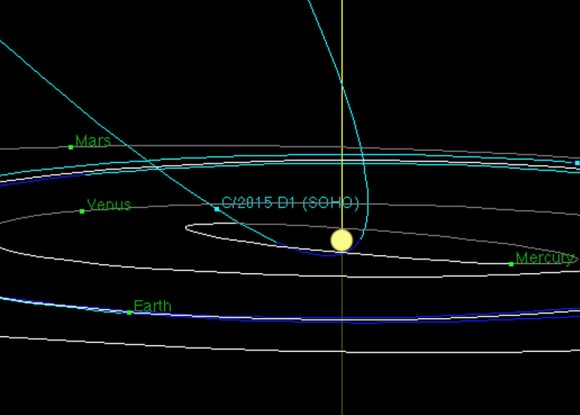
Comet D1 SOHO’s orbit is steeply inclined (70°) to the Earth’s orbit. After rounding the Sun, it turned sharply north and now rises higher in the western sky with each passing night for northern hemisphere skywatchers. Pity that the Moon has been a harsh mistress, washing out the sky just as the comet is beginning to gain altitude. These less-than-ideal circumstances haven’t prevented other astrophotographers from capturing the rare sight of a tailless comet. On Feb. 2, Jost Jahn of Amrum, Germany took an even clearer image, confirming Cowart’s results.
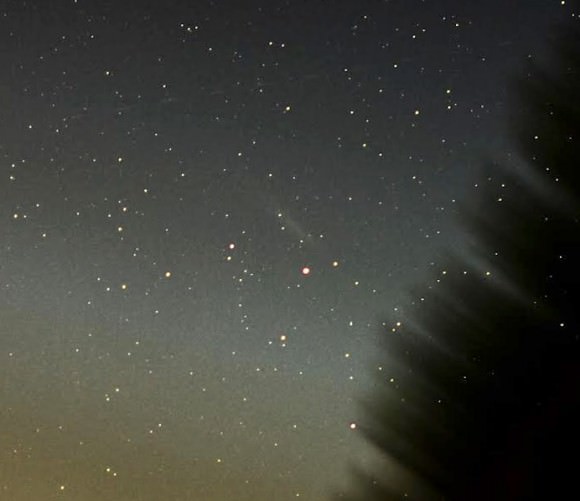
To date, there have been no visual observations of D1 SOHO made with binoculars or telescopes, so it’s difficult to say exactly how bright it is. Perhaps magnitude +10? Low altitude, twilight and moonlight as well as the comet’s diffuse appearance have conspired to make it a lofty challenge. That will change soon.
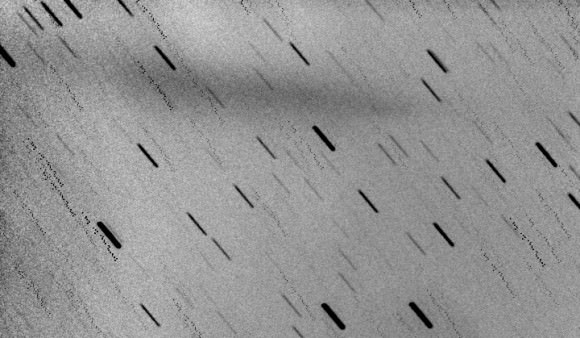
Once the Moon begins its departure from the evening sky on March 6-7, a window of darkness will open. Fortuitously, D1 SOHO will be even higher up and set well after twilight ends. I’m as eager as many of you are to train my scope in its direction and bid both hello and farewell to a comet we’ll never see again.
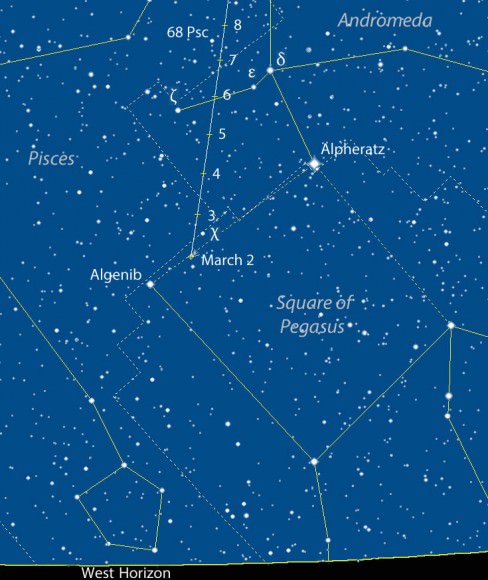
Here are fresh maps based on the most recent orbit published by the Minor Planet Center. Assuming you wait until after Full Moon, start looking for the comet in big binoculars or a moderate to large telescope right at the end of evening twilight when it’s highest in a dark sky. The comet sets two hours after the end of twilight on March 7th from the central U.S.
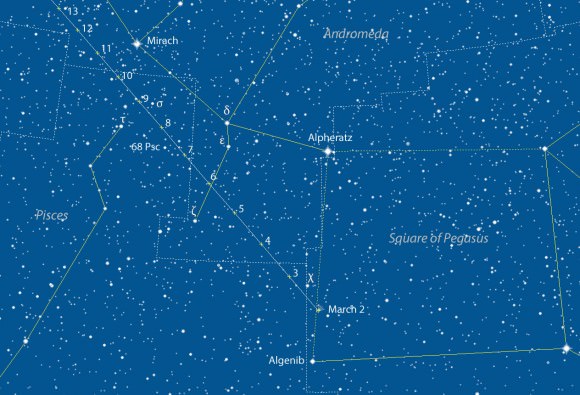


Dang… looks like this one will be known as a ‘could have been’ comet?
And once again, I have been reminded of a SciFi short story I once presented as a layout. It goes something like this: An interstellar voyager comes into our solar system. The ship itself is actually quite small, about 50 meters in diameter. The crew set out on their voyage thousands of years ago and has since slept in stasis. As the ship enters our solar system long dormant systems come to life. Most importantly is the fusion power plant that powers most every function. As the ship approaches Sol protective layers of water ices encasing the hull begin to sublimate away. This creates an extremely long comet like tail. The course set long ago has carried the craft to a close encounter with our star. This serves the dual purpose of melting away radiation shielding ices surrounding the craft while also decelerating the vehicle. Now comfortably settled into a long elliptical around Sol.. the crew is revived to ‘phones home’ and begin to making observations of Earth and it’s inhabitants…
Cool, no pun intended, idea – encasing the interstellar SC in ice. So they wake up, the retros are fired to enter Solar orbit. Somewhere in this vast Universe, someone has done this but copyright doesn’t protect E.T.s
Interesting idea. An ice shell would definitely go a long way towards protecting the sleepers from micrometeoroid imapcts. I have a quibble though, and that’s about the sunlight slowing the craft down enough to be captured by the Sun. Your spaceship’s velocity will be large compared to other comets, because it comes from interstellar space, so it will take more than radiation pressure to influence its orbit.
Instead, can I suggest a gravitational encounter with Jupiter? According to Wikipedia, Jupiter is capable of capturing interstellar comets into a Sun-centered orbit. Aiming the craft precisely enough to do this is probably within your alien race’s ability.
Actually I was thinking that dipping through and engaging Sol’s magnetic field(s) would do much of the braking. Then orbital adjustments are made with fusion powered plasma jet rocket engines… of course!
“..protective layers of water ice(s) encase…” Providing shielding for radiation and micro meteor impact. The ices are accumulated via a “Bassard” like magnetic field induction around the hull as the ship accelerates thru the interstellar medium allowing it to gain velocity first, then protective mass.
Great idea Aqua4U!
the only drawback I can think of is the necessity to assemble the SC at a certain distance from the departing system’s star. You can even use the ice as the propulsion fuel source. If an impact damages the ice’s surface, we could have a zamboni-like re-surfacing machine. After the Canadarms used on the space shuttles and the ISS, that would be a great Canadian contribution to interstellar space exploration. 🙂
The sun’s magnetic field won’t break anything.
Electro magnetic forces only work short ranged. From a safe distance the average magnetic field is near zero. And at the surface where it could have an effect it is completely erratic and random. Your space craft might be accelerated instead of slowing down if it comes near the wrong spot.
What would work if they use the heating up of the ice as a steam engine rocket exhaust.
“Electro magnetic forces only work short ranged.” That’s why this craft has the technology to shield it as it dips into the corona which allows it to get close enough to use those emerging plasma generated magnetic fields.. as brakes.
Great article Bob. I like your referring to this (elsewhere) as being “isonized”. This one was certainly isonized. The dynamic range of digital sensors has continued to improve over the last 10 years. How much – I don’t know. How much? But one thing is for sure, it permits stacking short exposure images and revealing some incredibly faint objects. The recent images of comet Lovejoy might be a showcase of the state of amateur astrophotography. Its not a very bright comet but amateur photos have revealed incredible details.
Thanks Tim. Yes, thank goodness for CCDs. Can you imagine trying to get photos of this comet on Ektachrome-X with a single exposure? Ah, the bad old days.
“Look Fred, if you angle the emulsion just like this relative to the light – here, you can see it. There it is, that smudge. I’m pretty certain that is not an artifact or blemish.” 🙂 Or even hyper-sensitized 2415. Haven’t gotten deeply into solid-state astro-photography. Wonder if the techniques are as fun?
Bob,
You mention binos and also moderate to large scopes. Any idea of magnitude and size of this thing?
Hi Preston,
Not sure of the magnitude. My estimate based only on the photos is around 9.5-10 overall. I’ve yet to see any visual sightings or mag. estimates. Size looks to be very approximately 3/4 degree.
Preston,
Update on the tail length – as of today about 23′ and pointing in PA 84 degrees.